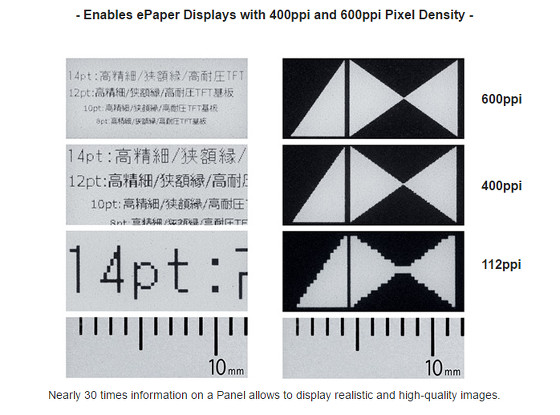Yesterday Japan Display announced plans to develop higher resolution epaper displays through a recent partnership with E Ink Holdings, makers of E Ink screens.
With resolutions of 400 ppi (pixels per inch) and 600 ppi, the new backplanes that Japan Display has developed are the highest resolution epaper displays in the world, they claim.
Current E Ink ebook readers like Kindles and Kobos top out at 300 ppi.
Entry-level models like the $79 Kindle have lower resolution 167 ppi screens, and the difference is fairly considerable.
The higher resolution E Ink screens make text appear sharper and clearer, along with helping the text look a bit darker.
The one downside with higher resolution E Ink screens is they tend to use more battery power, which kind of defeats one of the main advantages of E Ink.
For example, when Amazon released the Kindle Paperwhite with a 300 ppi E Ink screen, the battery life estimates went from up to 8 weeks to up to 6 weeks, a drop of 25%. And that was only going from 212 to 300 ppi. How much worse would battery life be with a jump up to 400 or even 600 ppi?
Personally I’m skeptical about the usefulness of such high resolution screens when it comes to ebook readers. I doubt the increase in resolution would be perceptually significant enough to justify the drop in battery life and overall performance, but it would be interesting to see the screens in person to find out.
Here’s a quote from the press release that explains Japan Display’s intentions for the new higher resolution screens:
JDI’s goal in developing its latest ePaper backplane is for ePaper to empower not only high resolution and battery-powered devices such as eBooks, smartphones and tablets, but also future devices for the “Internet-of-Things” (IoT).
It sounds like ebook readers are definitely one of the main target sources for the higher resolution screens, especially with phones and tablets being such a small part of the market for E Ink screens.


The display technique would still maintain its benefits, even with reduced battery life, especially with IOD devices, which might find themselves out in the field. In that situation, I can imagine solar chargers , maybe charging SuperCaapciters, serving the bill.
Like, you, I’m not certain if the higher density will produce noticeably clearer text, but the perceived higher contrast would certainly help with images and PDF files. The upside, is that 300 DPI might be considered the minimum standard for publishing on e-ink, matching the traditional print standard, at last, with recommendations inset images requirements taking that into consideration. Hopefully 32GB storage will become, as well to follow suite. 😉
The changes are very slowly, years for Minimum upgrades. Size. Ppi. Internal store. Light. Waterproof. Color?. Better one feature. Downgrade others. Like a weird game. Sale for few people. Very expensive. Example all kindles get 6″. Others more big. Other waterproof. Other like onix n96 and its family. But never a n96 with all the best. Max not Touch, only pen. Sony dpt, and its new rp1 only in japanese. I love this devices but O don’t understand its marketing.
Yeah I agree with this post. E-ink and others have been posting press releases about 300 dpi+ screens for years. And yet if you’re a developer looking to actually buy one for prototyping, all you’ll find available are the same ten or so 112/120 displays that we’ve seen for the better part of a decade. So unless you’re Amazon, or some other company with a large installed base, they’re not interested. And if I get a large installed base with OLED, the last thing I’m going to do is re-architect my product to switch to a niche technology that wants to stay that way.
I was on the sales side. I get it. You can’t sell a big company you’re courting on a $10,000 pilot program if the evaluators can do it themselves for $100 worth of parts you already sell on digikey. So the sales team screams that they can’t win big enterprise accounts if you make prototyping kits with your best tech available, because they can’t manage the sales cycle and get customers invested. This is how good tech makes itself too narrow and how companies get locked into servicing the same 2-3 customers and don’t know why they can’t break out.
So, no, I don’t think we’ll see this spread beyond ebooks, and at that you won’t see much innovation. Lots of press releases, lots of bold advances that are coming Real Soon Now, but somehow all we ever can buy are the same old screens.
In the very small percentage of the cases where pictures/diagrams are important these higher resolution screens would be of value. I guess they would be of value for comics/graphic novels/manga also. But in all of these cases, I think a tablet would be a better choice for reading that type of content. When moving from the Nook Simple Touch (167 PPI) to the Glowlight plus and Kobo Aura One (300 PPI) I do have to admit the higher resolution creates a better reading experience. That said, even the 167 PPI NST has sharper (though not darker) text than most physical books I own.
300ppi IMHO is good enough on an e-ink reader.
In fact, 167ppi is probably good enough for most people. It is for me. I own a basic Kindle and a Sony PRS-T1 that both have the lower resolution screens and both are completely fine.
If anything for an e-reader I’d like better PDF handling capabilities for reading PDFs on 6″ e-readers.
I’d love a 12″+ huge e-reader for PDFs, but right now they are still too expensive. 🙁
The main disadvantage of current e-ink displays is the insufficient resolution. It defeats the main point of such eReaders (for me…) – it’s not (yet) like a book. I hope that 600dpi will make it. Until then I still give eReaders a pass.